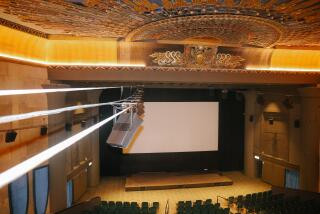From the Archives: Reliving the grandeur of ‘Lawrence of Arabia’
- Share via
At one point during the arduous filming of David Lean’s 1962 Oscar-winning historical epic “Lawrence of Arabia,” production shut down for three months. Screenwriter Robert Bolt needed the time to finish the script on the complex tale of T.E. Lawrence, the young British intelligence officer in Cairo who helped the Arabs break up the Ottoman Empire.
But then Bolt got arrested in London. A political activist, Bolt was jailed for protesting the proliferation of nuclear weapons. If he apologized for his actions, he wouldn’t go to prison.
“He refused to apologize,” said Anne V. Coates, the Oscar-winning editor of the film that made stars out of Peter O’Toole as Lawrence and Omar Sharif as Sherif Ali. Its 50th anniversary will be celebrated with a screening Thursday evening at the Academy of Motion Picture Arts and Sciences’ Samuel Goldwyn Theater.
------------
FOR THE RECORD:
“Lawrence of Arabia”: An article about “Lawrence of Arabia” in the July 18 Calendar section said that a restored version of the 1962 film would be released on Blu-ray Nov. 14. The release date is Nov. 13.
------------
“They wouldn’t let him out,” recalled Coates, speaking by phone from London. “So [producer] Sam Spiegel went down to the jail and pleaded with him.” Bolt agreed to apologize but regretted his decision and never spoke again with Spiegel after the film was completed.
Bolt’s incident was just one of the many hurdles the production endured during its one-year shooting schedule, which included maneuvering 65-millimeter cameras in the desert and trying to keep camels from getting seasick while traveling by boat from Jordan to Spain.
O’Toole, who earned his first of eight lead actor Oscar nominations for his performance, lost 28 pounds from his already reed-thin frame, sprained one ankle and broke the other, dislocated his back and cracked his skull.
“Lawrence of Arabia” opened in December 1962 and the 216-minute epic earned 10 Oscar nominations, winning Academy Awards for best picture, director, color art direction, color cinematography, editing, music and sound.
The academy’s Ellen Harrington, who programmed the sold-out evening — there will be a standby line that evening — said the film is as pertinent today as it was half a century ago. She offered praise for the “grandeur of it, the scale of it, the visual impact of it,” adding: “It is an incredibly impressive film from the color art direction, which was an Oscar winner, to the cinematography, the incredible music by Maurice Jarre … the sophistication of the dialogue and the relationships. And then of course, David Lean as the coordinator and visionary.”
Sharif was popular in Egypt when he was cast as Lawrence’s friend Sherif Ali, who is introduced in the film through a long shot of him traveling on a camel in the desert. “I loved him very much,” said Sharif of Lean, speaking by phone from Paris.
Sharif said he got the role, for which he received a supporting actor nomination, because he spoke English. “They looked at photographs of all the Egyptian actors, and David said if he speaks English, bring him here,” Sharif recalled.
Editing the film was also a big break for Coates, who had cut a few features but nothing of the scope of “Lawrence.”
“It was nerve-racking cutting for David Lean because he was one of the champion editors,” she said. “I was terrified, but I am a fairly go-ahead person so I went ahead and did it.”
Coates suggested to Lean editing the second half of the film first. “The main reason was there was much more action in it, the trains and the fights and the big blood bath,” she said. “It was much more difficult and complicated for the sound department. The other part was camels plodding across the desert, but not so much action.”
Over the years, the film was cut from its original length — a 187-minute version was released in the early 1970s to get more showings. But in 1989, a restored “director’s cut” done by Robert A. Harris and Jim Painten under Lean’s supervision was released.
The academy screening marks the U.S. premiere of the new digital restoration of the film, which used the original 65-millimeter negative.
“The original negative itself was actually quite scratched and not in good shape,” said Grover Crisp, executive vice president, asset management, film restoration and digital mastering for Sony Pictures Entertainment. But with digital restoration, “the original negative is kind of the Holy Grail in this kind of work because the detail and sharpness were there in the negative so we wanted to work with that.”
For more information, go to www.oscars.org.
More to Read
Only good movies
Get the Indie Focus newsletter, Mark Olsen's weekly guide to the world of cinema.
You may occasionally receive promotional content from the Los Angeles Times.











